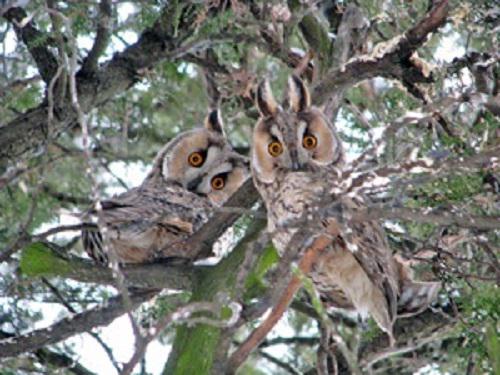Milan Ruzic
The mail goal of our project is to establish long-lasting conservation measures for Long-eared Owl winter roosts as the model for future conservation of all winter roosts in Serbia.

© Milan Ruzic.
Long-eared Owls inhabits woodland and open-country habitats across Europe, North Africa, Asia and North America. Its populations have declined in many European countries due to habitat change and loss. The population trend in Serbia is unknown. Significant numbers of this owl gather at traditional winter roosts, where systematic counts offer critically important data on owl numbers and trends. In northern Serbia, initial surveys have located numerous winter roosts in villages and towns. However, many of these roosts are endangered by tree cutting, disturbance or shooting. Work under this project will conserve roosting sites through research and monitoring, information boards and an educational campaign.
There are numerous large winter roosts on traditional sites in villages and towns in north Serbia and some of them are the world's largest (e.g., Kikinda with more than 730 birds!). The Province of Vojvodina is a mostly treeless agricultural landscape and owls are attracted to roost sites within human settlements. They typically roost in coniferous trees where they remain in close vicinity to a large number of people. As the subject of superstition, owls are endangered by tree cutting, disturbance and shooting at some roost sites. During this project roosts will be researched and monitored, information boards will be set-up and educational campaign will be conducted in 12 towns and villages.
Modern agricultural techniques have increased agricultural production but has increased the number of pests as well. Food availability in agricultural fields encourages population growth of rodents which periodically cause crop damage. To combat rodents, farmers use rodenticides, although this technique is expensive and requires frequent reapplication. In addition, rodenticides poison the soil and water systems and have secondary health effects on wildlife. The natural biological control offered by owls substantially decreases rodent numbers, thus lowering crop damage and eliminating the use of rodenticides. According to numerous international research, owl conservation measurements can greatly decrease crop damages done by overpopulated rodents in an ethical, environmentally friendly and economical way. Therefore, preserving natural predator and prey relationships in agricultural landscapes is becoming essential tool for ecosystem conservation and sustainable development of rural communities. Conservation of winter roosts will also help the local communities through the development of eco-tourism (birdwatching). The mail goal of our project is to establish long-lasting conservation measures for Long-eared Owl winter roosts as the model for future conservation of all winter roosts in Serbia (and elsewhere in Europe).